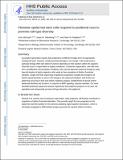Planarian Epidermal Stem Cells Respond to Positional Cues to Promote Cell-Type Diversity
Author(s)
Wurtzel, Omri; Oderberg, Isaac Max; Reddien, Peter
Downloadnihms852959.pdf (2.966Mb)
PUBLISHER_CC
Publisher with Creative Commons License
Creative Commons Attribution
Terms of use
Metadata
Show full item recordAbstract
Successful regeneration requires that progenitors of different lineages form the appropriate missing cell types. However, simply generating lineages is not enough. Cells produced by a particular lineage often have distinct functions depending on their position within the organism. How this occurs in regeneration is largely unexplored. In planarian regeneration, new cells arise from a proliferative cell population (neoblasts). We used the planarian epidermal lineage to study how the location of adult progenitor cells results in their acquisition of distinct functional identities. Single-cell RNA sequencing of epidermal progenitors revealed the emergence of distinct spatial identities as early in the lineage as the epidermal neoblasts, with further pre-patterning occurring in their post-mitotic migratory progeny. Establishment of dorsal-ventral epidermal identities and functions, in response to BMP signaling, required neoblasts. Our work identified positional signals that activate regionalized transcriptional programs in the stem cell population and subsequently promote cell-type diversity in the epidermis.
Date issued
2017-03Department
Massachusetts Institute of Technology. Department of BiologyJournal
Developmental Cell
Publisher
Elsevier
Citation
Wurtzel, Omri et al. “Planarian Epidermal Stem Cells Respond to Positional Cues to Promote Cell-Type Diversity.” Developmental Cell 40, 5 (March 2017): 491–504 © 2017 Elsevier Inc
Version: Author's final manuscript
ISSN
1534-5807
1878-1551